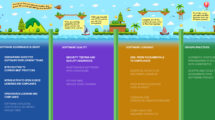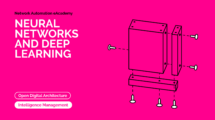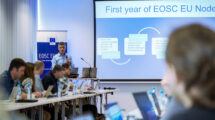Words: Maria Isabel Gandia Carriedo (CSUC) and Eldis Mujaric (CARNET)
Organisations with advanced capabilities in Orchestration, Automation and Virtualisation (OAV) are more likely to succeed in their path towards digital transformation. But how can the progress in these areas be accurately measured? And how can organisations identify the actions needed to drive further advancement?
Maturity Models are valuable instruments to support in any transformation process, as they can help to evaluate an organisation’s current levels on certain capabilities and provide indications on how to improve. With that in mind, the Network eAcademy team of the GÉANT project (currently GN5-2 WP6) developed the OAV Maturity Model, a structured framework that NRENs and R&E organisations can use to measure their OAV level in different areas, as well as a dedicated OAV Maturity Model survey, helping them to self-assess their capabilities over time and advance in their digital transformation.
A Model Tailored for Research and Education
One size never fits all, especially in a community as diverse as the Research and Education one. Recognising the significant differences between organisations in areas like service lifecycle management, automation of processes, analytics, or artificial intelligence, the OAV Maturity Model was designed to be as broadly applicable as possible. By benchmarking current capabilities, in the form of dimensions and sub-dimensions, and against a series of well-defined maturity stages, the model offers a snapshot of the present status for each item and a clear roadmap toward a more integrated, agile, and future-proof digital infrastructure.
Four Dimensions for a Holistic Assessment
The model aims to evaluate OAV adoption comprehensively and it is organised into four primary dimensions, which, in turn, are divided into sub-dimensions. These clearly identify strengths and points to improve, as well as threats and opportunities:
- Architecture & Technology: This dimension evaluates the technical backbone—from the integration of network components and APIs to virtualisation and AI-driven analytics. It stems from the question: are your tools communicating effectively, and is your architecture agile enough to support rapid change?
- Processes & Services: Beyond technology, transformation relies on streamlining service design and automating processes. This dimension measures how well an organisation has evolved from manual operations to fully orchestrated, service-driven workflows.
- Vision & Strategy: Digital transformation starts at the top. This dimension looks at whether an organisation’s vision for OAV is aligned with its business objectives, how well policies are developed and enforced, and whether a strategic roadmap is in place.
- People & Organisation: Finally, a successful transformation relies on people. Here, the model examines team structures, stakeholder engagement, and the cultural mindset that drives continuous learning and innovation.
The Six Stages: From ‘Sit’ to ‘Energise’
The model is built around six stages:
- None (Sit): Organisations at this level operate traditional, siloed architectures with minimal or no OAV elements.
- Ad Hoc (Crawl): Early interest emerges as teams begin experimenting with automating isolated tasks.
- Reactive (Walk): OAV becomes part of strategic decision-making, with pilot projects and initial cross-departmental collaborations underway.
- Integrated (Run): A fully transitioned OAV architecture is in place, supported by standardised APIs, common data models, and orchestrated processes.
- Proactive (Fly): Organisations are upgrading to advanced, multi-domain platforms that support predictive analytics and closed-loop processes.
- Self-* (Energise): At this cutting-edge stage, systems are self-discovering and self-optimising—fully autonomous and seamlessly interoperable.
Why It Matters
For NRENs and other R&E organisations, the OAV Maturity Model is more than a self-assessment tool—it’s a strategic asset. By self-assessing their capabilities through the OAV Maturity Model survey, organisations receive a confidential report that highlights strengths, identifies areas for improvement, and even benchmarks their progress against community averages. Such insights are invaluable for prioritising investments and tailoring training initiatives, ensuring that digital transformation efforts are measurable and actionable. Organisations can also re-evaluate their level over time by filling in the survey periodically, to identify if their actions have worked, what has already been accomplished, and the steps needed to reach the desired status.
An enhanced OAV Maturity Model Survey
In an effort to improve accessibility and clarity, the Network eAcademy team recently refined the OAV Maturity Model survey, colour-coding responses according to the maturity stages and making it easier to identify each level. Definitions of all the sub-dimensions – previously available only in the wiki and whitepaper – have now also been added to the survey.
Completing the OAV Maturity Model survey is a practical and effective way to understand where your organisation stands and set the course for growth. We invite all NRENs and R&E organisations in our community to do so. Upon completion, you will receive a detailed report outlining your organisation’s current OAV maturity level and tailored recommendations, suggesting the next steps to take. Please note that the information you provide will remain strictly confidential and will not be disclosed. This means that you will receive an accurate understanding of your organisation’s maturity level and improvement areas, while safeguarding your organisation’s data.
Charting the Future
The journey from “Sit” to “Energise” is not just about technological upgrades; it’s about fostering a culture of continuous improvement and innovation. The model’s flexibility allows organisations to set realistic, achievable targets that reflect their unique needs and market conditions. The progressive adoption and refinement of the OAV Maturity Model by NRENs will bring about a collaborative, community-driven evolution in digital transformation —one that promises to make networks smarter, more resilient, and truly future-ready.
For more details about the model and supporting materials, please visit our pages:
- MM Pages: OAV Maturity Model Wiki
- MM Whitepaper: GN5-1 White Paper: OAV Maturity Model







